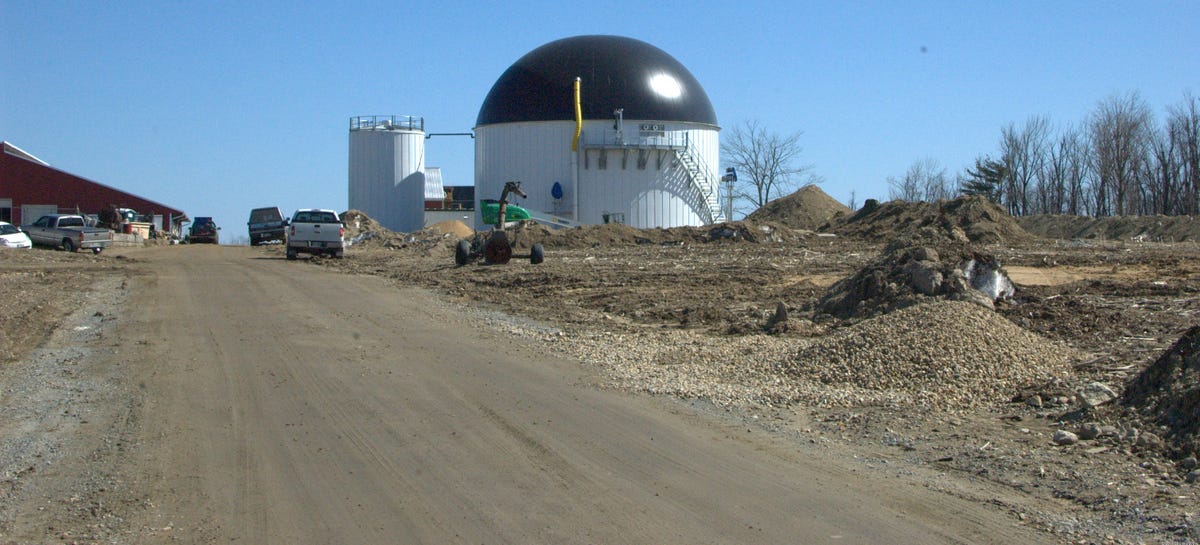Turning farm waste into biogas (photos)
Five small family dairy farms in Massachusetts will use an anaerobic digester to transform manure and food waste into biogas as a way to consume waste and generate revenue.

Dome on the hill
RUTLAND, Mass.--It's not a common site on farms but the domed silo on this hill is an anaerobic digester, which will produce biogas through naturally occurring bacteria. The biogas will be siphoned of and used as a fuel for an electricity generator. It's part of a project among five farms in western Massachusetts to reduce manure waste and make power on site with the digester. This first one is going up at the Jordan Dairy Farm where the owner expects to feed enough surplus electricity to the grid to power 2,000 homes and earn him some additional revenue. The biogas will be made when bacteria digest cow manure and food waste which will be shipped in.
See related story: "Dairy farm feeds grid with manure and food waste."
Time for milking
The current manure management system at the Jordan Farm, which has about 300 cows at this location, is to collect the manure under the barn. Manure drops through the slots in the floor where it collects in a container and then is pumped into a lagoon. When warmer weather came, the manure was sprayed on fields for fertilizer. With the digester, the farm will be able to make energy from the manure and shipped-in food waste and recycle the nutrients. At the end of the digestion process, the remaining liquid will be used as fertilizer.
Storage silo
When the new system is running, manure will be pumped into a storage container like this one along with liquid food waste from food-processing plants. It will then be pumped into the digester (with the black dome). This feedstock tank can hold 50,000 gallons and the digester tank can hold 500,000 gallons. The farm expects to have other storage tanks as the farm produces 10,000 gallons of manure a day.
CHP
In this container will be a combined heat and power machine which will provide heat for the digester which needs to operate at 100 degrees Fahrenheit. Before slurry is pumped into the digester, it is heated in this machine which will capture heat from the adjacent 300-kilowatt generator.
Digester dome
The technology from the digester originally came from Germany where, like other European countries, there are many digesters already operating. The U.S. company now making the equipment is Quasar Energy Group, which has installed two of these digesters at farms in Ohio, with the largest having an electrical output of 1 megawatt. The dome is a membrane that protects the inner membrane which rises and falls depending on how much gas is produced.
Generator
This generator will run on biogas to make 300 kilowatts of power, enough for several hundred homes. The biogas from the digester will be about 60 percent methane and 40 percent carbon dioxide. From an environmental perspective, the biogas system is less polluting than leaving manure in lagoons or sending waste to landfills, where the waste gives off methane, a powerful greenhouse gas. The farm expects to put in a larger 450-kilowatt generator later.
Farmer Jordan
Farm owner Randy Jordan in a barn that houses his dairy cows, which produce 10,000 gallons of manure a day. Most digesters on farms have failed in the past, but he and other investors hope they have a better model. The digester will be operated by New England Organics, a division of Casella Waste Systems, a hauler and recycling company. Also, this farm will supplement its farm waste with liquid food waste from food processors, restaurants, and eventually grocery stores. Many digesters were meant as ways to deal with manure, but these anaerobic digesters will produce power as well, creating a revenue stream.
Digester side
Because the makeup of the food waste will vary, the plant operator expects to test incoming material to ensure the right biology in the digester. If too much hydrogen sulfide builds up, for example, it can corrode the machinery. The blue cap is the end of a propeller which will mix the material inside which aids in gas production. The yellow tube is a blower to keep the black outer membrane fully inflated and covering the internal membrane which will rise and fall with the production of gas.
Slurry store
After gas is produced, there will be some residual liquid. That will be dewatered to make a fibrous material which can be used as animal bedding. The remaining liquid will be stored in this container and then sprayed onto the field as fertilizer. Since everything is recycled, the nutrients from the food will remain in this liquid and be fed back to the soil.

